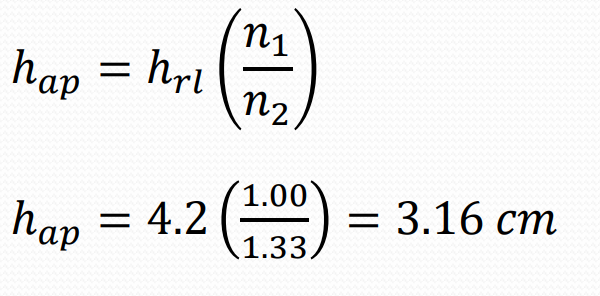Chapter 9 The Refraction of Light: Lenses and Optical Instruments
1/36
Earn XP
Description and Tags
Name | Mastery | Learn | Test | Matching | Spaced |
|---|
No study sessions yet.
37 Terms
A light ray strikes an air/water surface at an angle of 46 degrees with respect to the normal. Find the angle of refraction when the direction of the ray is (a) from air to water and (b) from water to air.
33 and 74 degrees
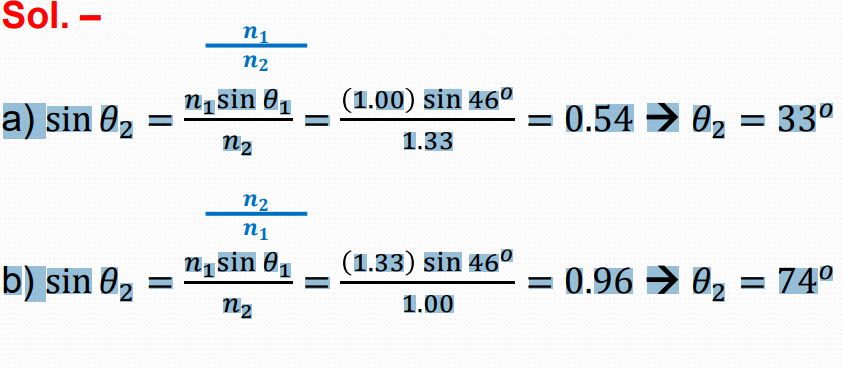
The searchlight on a yacht is being used to illuminate a sunken chest. At what angle of incidence should the light be aimed?
44 degrees
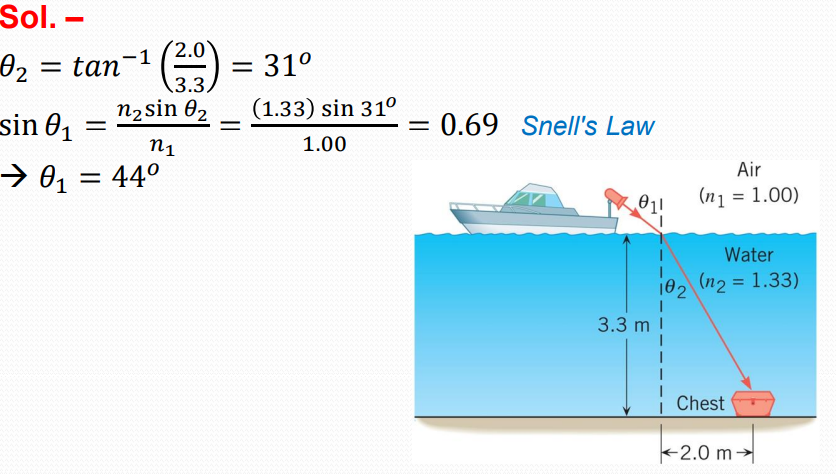
Red light of wavelength 750 nm (in vacuum) enters a glass plate of refractive index `𝑛 = 1.5. If the velocity of light in vacuum is 3.00 × 108 𝑚/𝑠, calculate velocity, wavelength and frequency of light in glass.
500 × 10−9 𝑚, 2.00 × 108 𝑚/�,4 × 1014 𝐻𝑧

- A beam of light is propagating through diamond (n1=2.42) and strikes a diamond–air interface at an angle of incidence of 28 degrees. (a) Will part of the beam enter the air (n2=1.00) or will the beam be totally reflected at the interface? (b) Repeat part (a), assuming that the diamond is surrounded by water (n2=1.33) instead of air.
24.4 and 33.3 degrees
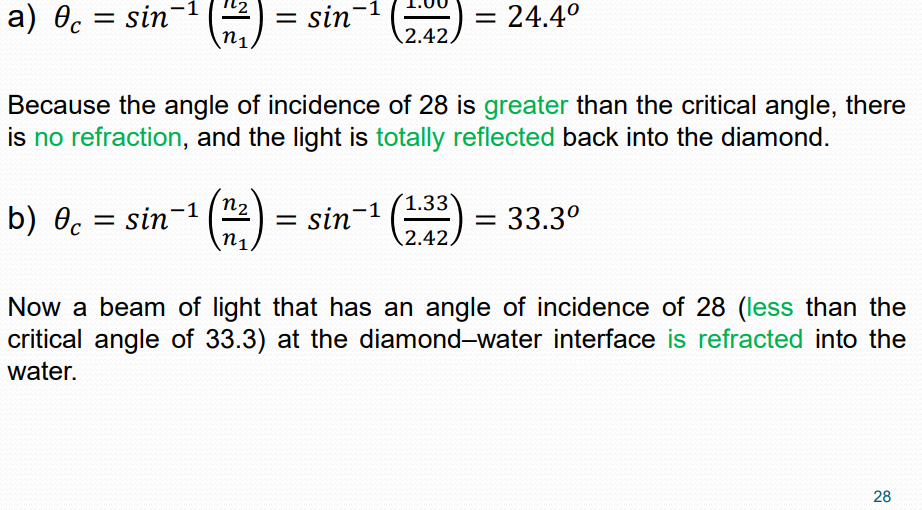
It is possible for a prism to bend light upward, downward, or not at all. How can the situations depicted in the figure arise? (downward)
A ray bends away from the normal when it travels from a medium with a larger refractive index (𝑛2) into a medium with a smaller refractive index (𝑛1). When the ray leaves the prism, it again bends downward, which is away from the normal at the point of exit.
𝑛1 = 1.000 air 𝑛2 = 2. . 632 diamond 𝑛2 > 𝑛1
It is possible for a prism to bend light upward, downward, or not at all. How can the situations depicted in the figure arise? (upward)
A ray bends toward the normal when traveling from a smaller refractive index (𝑛2) toward a larger refractive index (𝑛1) . Thus, the situation in Figure could arise if the prism were immersed in a fluid, such as carbon disulfide, that has a larger refractive index than does glass (see the Table).
𝑛1 = 1.632 carbon disulfide 𝑛2 = 1.523 glass 𝑛2 < 𝑛1
It is possible for a prism to bend light upward, downward, or not at all. How can the situations depicted in the figure arise? (not at all)
A prism will not bend a ray at all, neither up nor down, if the surrounding fluid has the same index of refraction as the glass—a condition known as index matching. 𝑛2 = 𝑛1
A 1.70-m tall person is standing 2.50 m in front of a camera. The camera uses a converging lens whose focal length is 0.0500 m. (a) Find the image distance and determine whether the image is real or virtual. (b) Find the magnification and height of the image on the film.
-0.0347 m
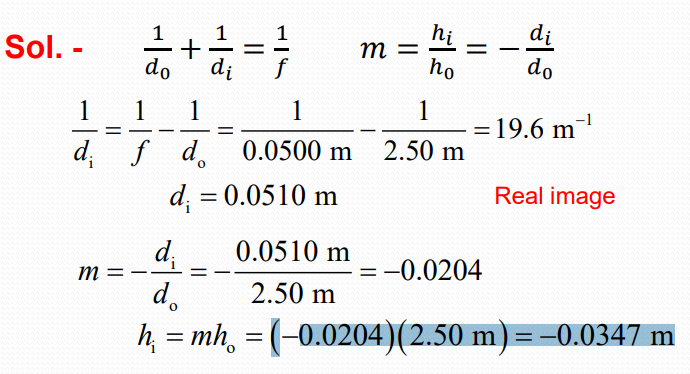
In which one of the following substances does light have the largest speed?
a) diamond
b) benzene
c) carbon dioxide
d) Water
e) none of the above. The speed of light has the same value everywhere in the Universe.
c)carbon dioxide
Through experiment, the speed of light passing through material A is 1.4 times greater than when the same light passes through material B. What is the ratio of the refractive index of material A to that of material B?
a) 0.71 b) 0.84 c) 1.0 d) 1.2 e) 1.4
a)0.71
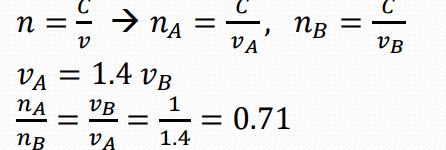
If the index of refraction for a given material is 1.5, what is the speed of light in that material relative to the speed of light in a vacuum, c? a) No material can have an index greater than 1 since light cannot travel faster than c b) c/2 c) 2c/3 d) c e) 3c/2
c) 2c/3

One dark evening, you are standing at the edge of a swimming pool that is 1.21 m deep. Directing a flashlight down into the water, you notice a shiny metal plate at the bottom and hold the light there. The light from the flashlight enters the pool at an incident angle of 50.0 at a point 0.85 m from the edge you are standing near. How far from this edge is the metal plate?
a) 0.85 m b) 1.1 m c) 1.5 m d) 1.7 m e) 1.9 m
d) 1.7 m

You are standing directly above a fish in an aquarium. The actual depth of the fish is one-half the distance from the surface to the bottom. As you look down at it, where does the fish appear to be?
a) I see it at its actual depth.
b) I see it at the surface of the water.
c) I see it below its actual depth, but above the bottom of the aquarium.
d) I see it above its actual depth, but below the surface of the water.
e) I see it at the bottom of the aquarium.
d) I see it above its actual depth, but below the surface of the water.
A laser beam is directed at the left side of a plastic block as shown. Through which side and at what angle with the normal does the light leave the block? a) top side, 40 b) right side, 40 c) top side, 68.8 d) right side, 68.8 e) bottom side, 40
b) right side, 40

Is light bent more, less, or not at all when entering a medium with a larger index of refraction than that of the incident medium when the angle of incidence is greater than 0?
a) more b) less c) not at all d) Depends on the critical angle.
a)more
Blue light travels from air into glass that has an index of refraction of 1.54. How does the wavelength of the light in air compare with the wavelength of the light in the glass?
a) The wavelength of the light is the same in both media, only the frequency changes upon entering the glass. b) The wavelength of the light becomes shorter in the glass. c) The wavelength of the light becomes longer in the glass d) None of the above answers.
b) The wavelength of the light becomes shorter in the glass.
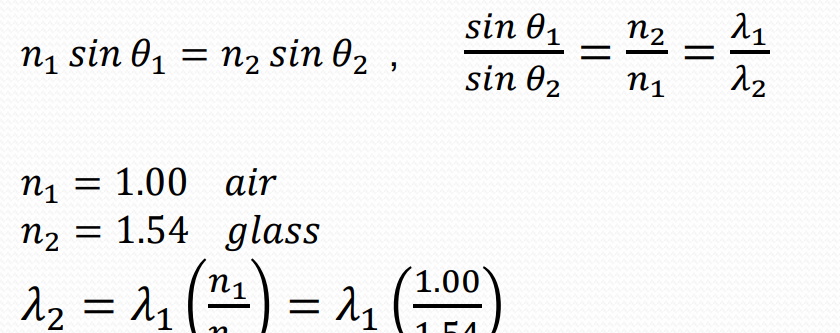
A single light beam is split into two equal beams, denoted A and B. Beam A travels through a medium with a higher index of refraction than the medium that beam B travel through. When both beams exit their media back into air, how do their wavelengths compare?
a) Beam A has a longer wavelength. b) Beam B has a longer wavelength. c) Both beams have the same wavelength. d) It depends on the dimensions of the meduims.
c) Both beams have the same wavelength
In which of the following cases, if any, does the angle of reflection not equal to the angle of incidence?
a) Light travels from a material with a lower index of refraction and reflects from the interface with a materials of higher index of refraction.
b) Light travels from a materials with a higher index of refraction and reflects from an interface with a material of lower index of refraction.
c) None of the light incident on a surface is refracted into the material.
d) Most, but not all, of the light incident on a surface is refracted into the material.
e) …in all of the above cases, the angle of reflection will equal the angle of incidence.
e) …in all of the above cases, the angle of reflection will equal the angle of incidence.
If total internal reflection is to occur, what must the incident angle be relative to the critical angle?
a) It must be equal to the critical angle.
b) It must be larger than or equal to the critical angle.
c) It must be smaller than or equal to the critical angle.
d) It must be smaller than the critical angle.
e) Total internal reflection only depends on the indices of refraction of the two materials, so it doesn’t matter what the incident angle is.
b) It must be larger than or equal to the critical angle.
A beam of unpolarized light is directed at a liquid within a transparent container. When the light strikes the air-liquid interface, Jason observes that the reflected ray and the refracted ray are perpendicular to one another. Investigating, Jason places a polarizer in the path of the reflected ray. What does Jason observe when the transmission axis of the polarizer is perpendicular to the surface of the water?
a) No light is transmitted through the polarizer.
b) About one quarter of the light is transmitted through the polarizer.
c) About one half of the light is transmitted through the polarizer.
d) About three quarters of the light is transmitted through the polarizer.
e) All of the light is transmitted through the polarizer.
a) No light is transmitted through the polarizer.
Which one of the following statements concerning refraction of light by a prism is true?
a) Light of higher frequency is refracted more than light of lower frequency.
b) Light of lower frequency is refracted more than light of higher frequency.
c) All light is refracted the same amount because the index of refraction of the prism is a constant for all frequencies.
d) None of the above answers.
a) Light of higher frequency is refracted more than light of lower frequency.
Which of the following is an example of dispersion?
a) A rainbow seems to connect two mountain peaks.
b) A magnifying glass is used to focus light to start a fire.
c) A spoon in a glass of water looks bent.
d) Snell’s law is a direct result from chromatic dispersion.
e) Laser light is used to accurately cut parts for an automobile.
a) A rainbow seems to connect two mountain peaks.
Parallel rays of red light that are directed at a converging lens are focused at a point P on the principle axis to the right of the lens when the lens is surrounded by air. If the lens is surrounded by water instead of air, where will the red parallel rays be focused relative to point P?
a) above point P
b) below point P
c) to the left of point P
d) to the right of point P
e) at point P
d) to the right of point P
The knight from a chess set is placed at the focal point of a diverging lens as shown. By carefully constructing a ray diagram, determine where the image of the knight will appear?
a) no image is formed
b) the image is at a distance f to the left of the lens, but it is inverted
c) the image is at a distance f to the right of the lens, and it is upright
d) the image is at a distance f/2 to the right of the lens, but it is inverted
e) the image is at a distance f/2 to the left of the lens, and it is upright
e) the image is at a distance f/2 to the left of the lens, and it is upright
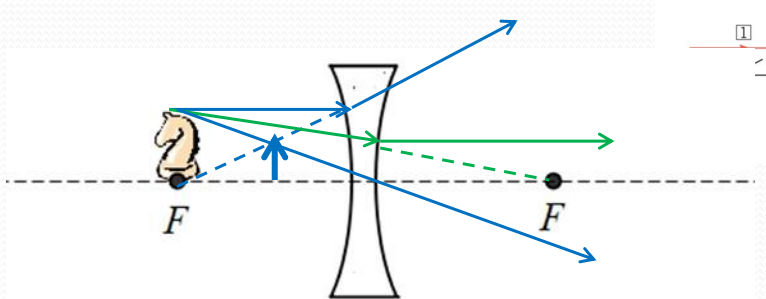
The knight from a chess set is placed at the focal point of a converging lens as shown. By carefully constructing a ray diagram, determine where the image of the knight will appear?
a) no image is formed
b) the image is at a distance greater than f to the left of the lens, but it is inverted
c) the image is at a distance greater than f to the right of the lens, and it is upright
d) the image is at a distance f/2 to the right of the lens, but it is inverted
e) the image is at a distance f/2 to the left of the lens, and it is upright
a) no image is formed
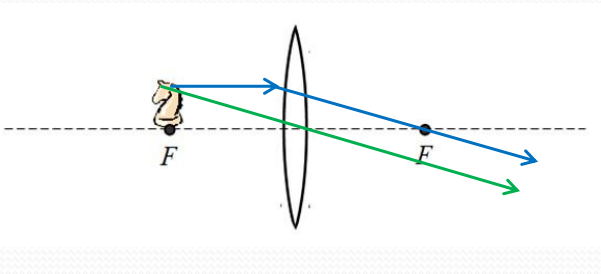
Which one of the following statements relating to index of refraction n is false?
a) Values of n are always greater than or equal to one. b) The speed of light in gases is only slightly less than that in a vacuum.
c) The index of refraction tends to be larger for solids than for gases.
d) Values of n for solids and liquids indicate that the speed of light in these substances is greater than that in gases.
e) The index of refraction is an important parameter in Snell’s law of refraction.
d) Values of n for solids and liquids indicate that the speed of light in these substances is greater than that in gases.
A real object is placed to the right of a converging lens at a distance 2f. The focal length of the lens is f. By carefully drawing a ray diagram for this situation, determine which of the following statements best describes the image formed.
a) An observer on the left side of the lens would see a real image to the left of the lens that is inverted and larger than the object.
b) An observer on the left side of the lens would see a real image to the left of the lens that is inverted and smaller than the object.
c) An observer on the left side of the lens would see a real image to the left of the lens that is upright and the same size as the object.
d) An observer on the left side of the lens would see a real image to the left of the lens that is inverted and the same size as the object.
e) An observer on the left side of the lens would see a virtual image to the right of the lens that is inverted and smaller than the obje
d) An observer on the left side of the lens would see a real image to the left of the lens that is inverted and the same size as the object.
- An object is placed to the left of a converging lens. The distance from the object to the lens is one and one-half times the focal length of the lens. A screen is used to view the image of the object on the right side of the lens. If the top half of the lens is covered with black electrical tape such that no light can enter the lens on that half, what would you see on the screen?
a) The top half of the image is no longer seen.
b) The bottom half of the image is no longer seen.
c) The upper most portion and lower most portion of the image are no longer seen.
d) The entire image is seen just as before.
e) The entire image is seen, but about one half as bright.
e) The entire image is seen, but about one half as bright.
Which one of the following phrases best describes images formed by diverging lenses?
a) always smaller than the object b) always larger than the object c) always inverted d) always virtual e) always real
d) always virtual
- A physics student desires to create a beam of light that consists of parallel rays. Which one of the following arrangements would allow her to accomplish this task?
a) A light bulb is placed at the focal point of a convex mirror.
b) A light bulb is placed at the focal point of a diverging lens.
c) A light bulb is placed at the focal point of a converging lens.
d) A light bulb is located at twice the focal length from a concave mirror.
e) A light bulb is located at twice the focal length from a converging lens.
c) A light bulb is placed at the focal point of a converging lens.
An object is placed at a distance 2f to the left of a converging lens with a focal length f. Using the thin lens equation and the magnification equation, determine the location and magnification of the image formed by this configuration.
a) The image is formed at a distance f to the right of the lens and it has a magnification of 1/2.
b) The image is formed at a distance 2f to the right of the lens and it has a magnification of 1/2.
c) The image is formed at a distance f to the right of the lens and it has a magnification of 1.
d) The image is formed at a distance 2f to the right of the lens and it has a magnification of 1.
e) The image is formed at a distance f/2 to the right of the lens and it has a magnification of 1/4.
d) The image is formed at a distance 2f to the right of the lens and it has a magnification of -1.
An object is placed at a distance 5.0 cm to the left of a converging lens with a focal length 2.5 cm. Using the thin lens equation and the magnification equation, determine the location and magnification of the image formed by this configuration.
a) The image is formed 2.5 cm to the right of the lens and it has a magnification of 1/2.
b) The image is formed 5.0 cm to the right of the lens and it has a magnification of 1/2.
c) The image is formed 2.5 cm to the right of the lens and it has a magnification of 1.
d) The image is formed 5.0 cm to the right of the lens and it has a magnification of 1.
e) The image is formed 1.25 cm to the right of the lens and it has a magnification of 1/4.
d) The image is formed 5.0 cm to the right of the lens and it has a magnification of 1.
An object is placed at a distance 5.0 cm to the left of a diverging lens with a focal length 2.5 cm. Using the thin lens equation and the magnification equation, determine the location and magnification of the image formed by this configuration.
a) The image is formed 1.7 cm to the left of the lens and it has a magnification of +1/3.
b) The image is formed 0.6 cm to the left of the lens and it has a magnification of +3/25.
c) No image is formed in this configuration.
d) The image is formed 0.6 cm to the right of the lens and it has a magnification of 3/25.
e) The image is formed 1.7 cm to the right of the lens and it has a magnification of 1/3.
a) The image is formed 1.7 cm to the left of the lens and it has a magnification of +1/3.
The compound microscope described in the text is made from two lenses. Which one of the following statements is true concerning the operation of this microscope?
a) Both lenses form real images.
b) Both lenses form virtual images.
c) Only the lens closest to the eye forms any kind of an image.
d) The lens closest to the object forms a real image; the other lens forms a virtual image.
e) The lens closest to the object forms a virtual image; the other lens forms a real image
d) The lens closest to the object forms a real image; the other lens forms a virtual image.
In her biology class, Chris examines an insect wing under a compound microscope that has an objective lens with a focal length of 0.70 cm, an eyepiece with a focal length of 3.0 cm, and a lens separation distance of 16.00 cm. Chris has a near point distance of 22.5 cm. What is the approximate angular magnification of the microscope as Chris views the insect wing?
a) 75 b) 110 c) 140 d) 190 e) 250
c)-140
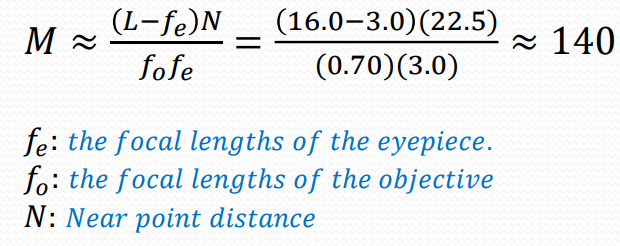
Which one of the following statements best explains why chromatic aberration occurs in lenses, but not in mirrors?
a) The shape of the mirror prevents chromatic aberration.
b) The thickness of a lens varies from top to bottom.
c) The frequency of light changes when it passes through glass.
d) The angle of incidence varies over the surface of a lens for incident parallel rays of light.
e) Different colors of light are refracted by different amounts as the light passes through a lens.
e) Different colors of light are refracted by different amounts as the light passes through a lens.
The observer is in air nearly above the object submerged in water (index of refraction 1.33). The depth of the object is 4.2cm. Find the apparent depth of the object. (Hint: Use Snell’s law of refraction and the fact that the angles of incidence and refraction are small, so tan θ ≈ sin θ.)
3.16 cm
